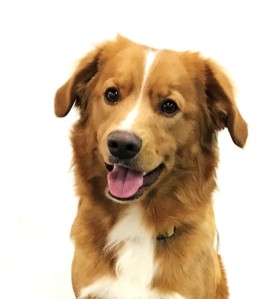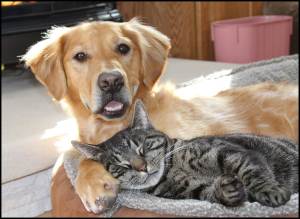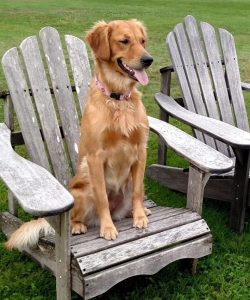Hello and Welcome to “The Science Dog”! Let me introduce myself. My name is Linda Case and I am a science writer and author, canine nutritionist and dog trainer. I specialize in topics about canine nutrition, health, training and behavior. My academic training is in animal sciences, specifically in canine/feline nutrition and companion animal behavior. I have a B.S. in Animal Science from Cornell University and an M.S. in Canine/Feline Nutrition earned at the University of Illinois. Following graduate school, I taught the undergraduate program in companion animal science in the Animal Sciences Department at the University of Illinois for 15 years and also taught companion animal behavior/training at the College of Veterinary Medicine for 5 years. I left academia several years ago to concentrate more on writing and teaching. Currently, in addition to writing books and this blog, I teach canine nutrition and feeding courses through The Science Dog Courses.
I am the author of numerous publications and nine books. My most recent books are “Feeding Smart with The Science Dog” (2022), “Dog Smart: Evidence-based Training with The Science Dog” (2018), Beware the Straw Man: The Science Dog Examines Dog Training Fact and Fiction” (2016) and “Dog Food Logic: Making Smart Decisions for Your Dog in an Age of Too Many Choices” (2014). More information about all of my dog books can be found in the Books section of this blog.
My husband Mike and I live with and love two amazing dogs; Alice (aka Ally) and Stanley, plus Pete, the (formerly feral) cat. In a nutshell, my work, my life and my happiness revolve fully and completely around dogs. I write about dogs, train dogs, teach other folks about dogs, play, run, hike and cuddle with dogs, and am fully capable of talking for hours on end about……dogs! Like many of you who are interested in this blog, I consider myself to be a card-carrying, lifetime, proud member of the “dog person” club.
So, welcome! I hope that you enjoy The Science Dog and look forward to reading your comments and suggestions! If you would like notification when new essays are posted, press the “Follow” button on the right side of the blog. You can also “Like” The Science Dog on Facebook! And, if you are interested in webinars and courses about canine nutrition and feeding practices, take a look at The Science Dog Courses! We would love to get to know you and your dogs through our courses!




Pingback: The Top 13 Dog Blog Posts of 2013 | No Dog About It Blog
What a great site. Thanks for putting research behind your posts. Nice job. Jeff Millman, Owner, Chicago Paws, LLC
LikeLike
Hi Jeff – Thanks for your note and comment! I am glad you like The Science Dog and the information it is providing – feel welcome to visit often! (BTW – We are neighbors, it seems. We are located in the Champaign-Urbana area!) Best, Linda
LikeLike
I am very impressed with your new book Linda, excellent and very thought provoking.
LikeLiked by 1 person
Thanks Graham – I am glad that you enjoyed it!
LikeLike
I’m nearly done with “Beware the Straw Man” and am enjoying thoroughly. Regarding dog parks, I’m not a big fan of the small enclosed dog parks, but we have one here in Addison, IL that’s about 80 acres. I find that there are less popular areas where my dog and I used to be able to walk (I am currently dogless) with few interactions with other dogs, This way the dog is off leash, having fun and I’ve only have one altercation in several years. So if the area is big enough to avoid competition, but only involves occasional passers-by, I’m not totally against dog parks.
LikeLike
looks like a great site! I’m always up for some more knowledge on canines!
LikeLike
What a great job you’re doing describing both canine and human behavior. A friend introduced me to your site via the dog park post. I couldn’t agree more that human behavior in dog parks is sometimes quite atrocious. My dogs and I avoid dog parks entirely: too potentially dangerous. Thanks.
LikeLike
A link to this just came up in my FB ‘memories’ from 15. Sept. 2013 when I shared your blog on my timeline. I have been following you ever since – great blog, thank you
Love your books too
LikeLiked by 1 person
Hi Lyn, Thanks so much for your note and kind words. I am so glad that you have been enjoying The Science Dog (and are one of its earliest fans!) and that you enjoy my books! I am finishing up a new book, to be published in early 2018, so look for it soon! Best wishes, Linda
LikeLike
Thought this might be of interest to you (same brands as dog foods – Purina, Hills, Wellness, Iams, etc.):
“A study that set out to measure how much wildlife domestic cats eat to supplement the food they are given by their owners was unsuccessful due to an unexpectedly high variability in cat food ingredients. This accidental discovery suggests that some cat food manufacturers regularly change ingredient composition, even within the same flavors of cat food.”
North Carolina State University. “Cat food mystery foils diet study.” ScienceDaily. ScienceDaily, 28 February 2020. <www.sciencedaily.com/releases/2020/02/200228105224.htm
Brandon W. McDonald, Troi Perkins, Robert R. Dunn, Jennifer McDonald, Holly Cole, Robert S. Feranec, Roland Kays. High variability within pet foods prevents the identification of native species in pet cats’ diets using isotopic evaluation. PeerJ, 2020; 8: e8337 DOI: 10.7717/peerj.8337
LikeLike
I love your Dog Food Logic book and am looking forward to reading your new Feeding Smart: Evidence-based Nutrition with The Science Dog when it comes out. In the meantime, I’m really enjoying your blog. Thanks for doing the work that you do.
LikeLike